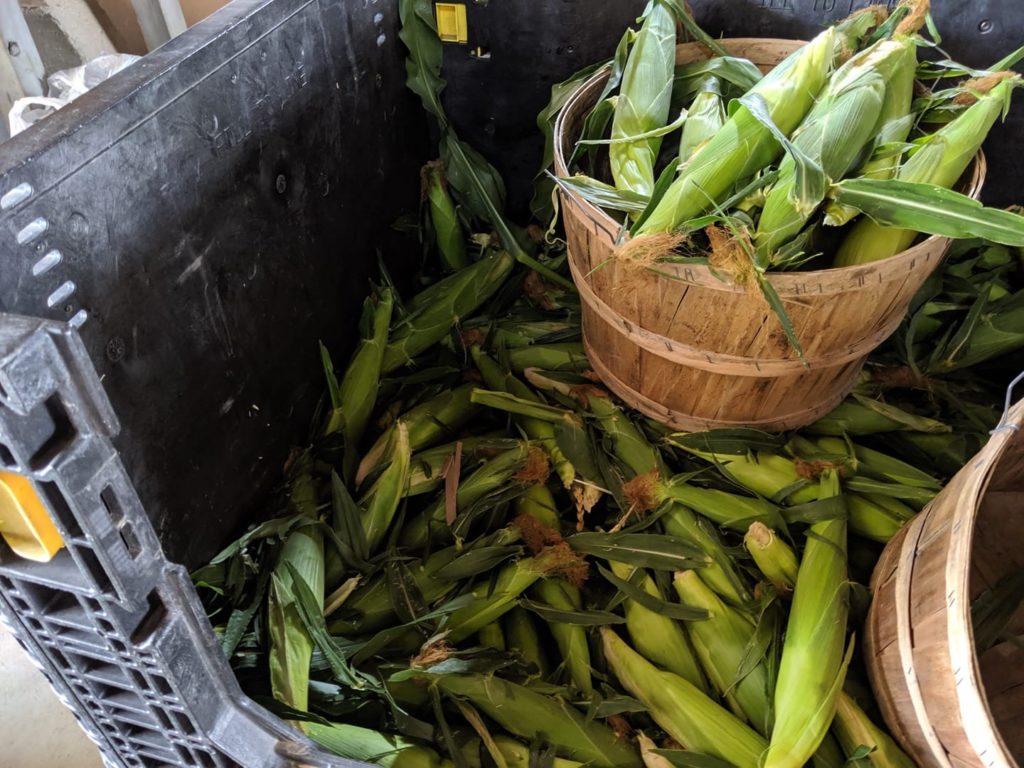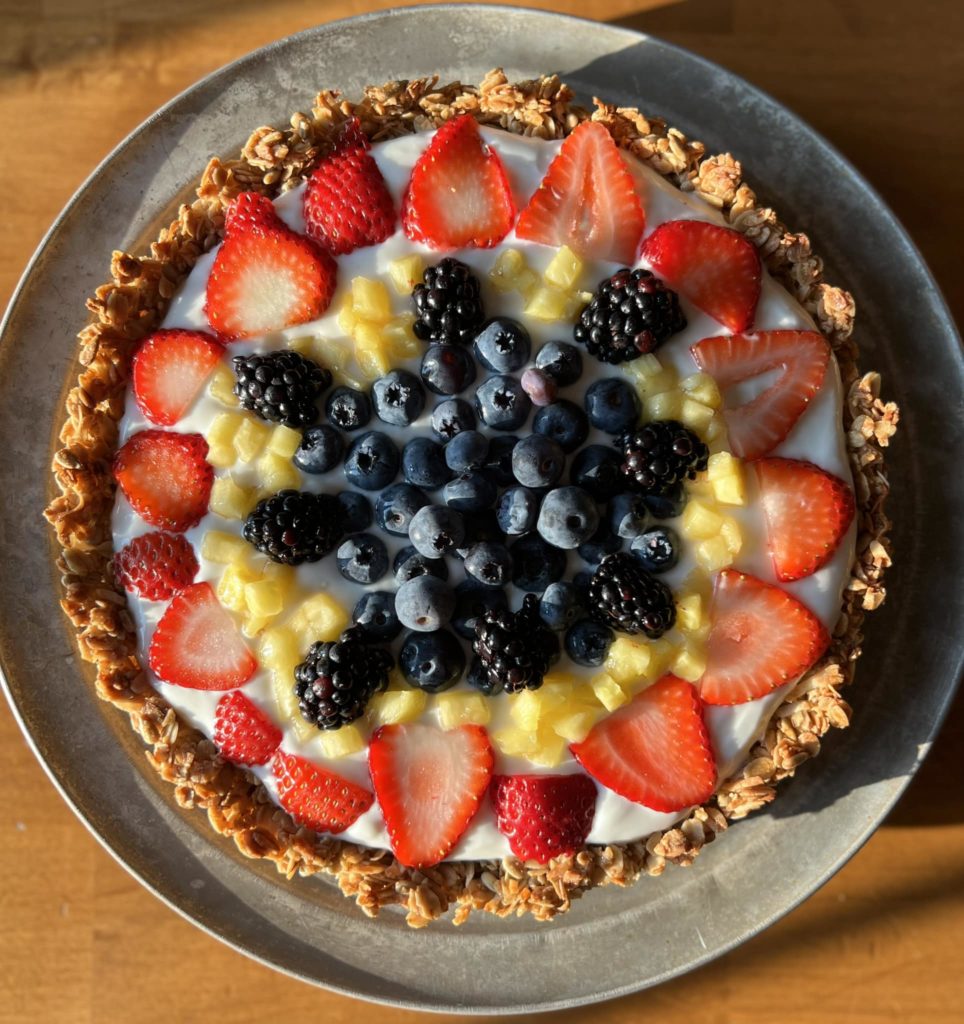Week 6 CSA Farm Newsletter (July 31 – August 4, 2023)
Farm Newsletter Week 6
July 31-August 4, 2023 | “B” Week
What’s in the Box this Week?
SWEET CORN (6 ears) ~ (not organic, non-GMO, from David Bench Farms) ~ To store: Refrigerate sweet corn as soon as possible with husks on. The longer you wait to eat it, the more sugar will turn into starch, and the corn will lose its \ sweetness. To prep: You can eat corn raw or cook it in the husks. Shuck the cob by pulling the husks down the ear and snapping off the stem. The silks will fall off as you cook the corn. Rinse under cold water. If you see a green worm, just cut out the damaged section — the rest of the cob is still edible! To cut the kernels off the cob, stand the cob upright on its base and run a sharp knife from the tip of the ear down to the base. To cook: Steam corn in 1-2 inches of water for 6-10 minutes, or drop ears into boiling water for 3-6 minutes. Season with butter or salt. You can also grill corn in the husk — place the corn in its husk in water for 10 minutes — then place on grill for 15 minutes. To freeze: Blanch on the cob for 3-5 minutes, rinse under cold water, and drain. Cut off the kernels with a knife, and then pack it into airtight freezer containers.
HEAD LETTUCE ~ Store unwashed lettuce in a Debbie Meyer Green bag or Tupperware FridgeSmart container in the refrigerator. To store lettuce that you have already washed and dried with a spinner, place back in a plastic bag with a dry paper towel in the bag, and place the package in the vegetable crisper bin. Use within 4 days. To prep: Wash leaves in a basin of cold water. Dry in a salad spinner. To freeze: Not recommended.
ORANGE CARROTS (with tops), 1 bunch ~ SAVE THE CARROT TOPS! You can make really cool stuff with them… To store, first take the tops off your carrots and put them into a plastic bag in the fridge. The roots should be stored separately in the crisper in a plastic bag. If they get soft, just put them in some water to crisp them up again. Eat within 3 weeks. Don’t throw the carrot greens away! Use them to make carrot top pesto! Or dehydrate them on your counter and add them as a parsley-type herb to future dishes. Or throw them into a “veggie scrap bag” in your freezer (with other things like the tops of celery, onion skins, carrot ends). When the bag gets full, use it to create your own DIY veggie broth (which you can then freeze into ice cubes for later use!) Not sure how to make DIY broth?… grab our guide here.
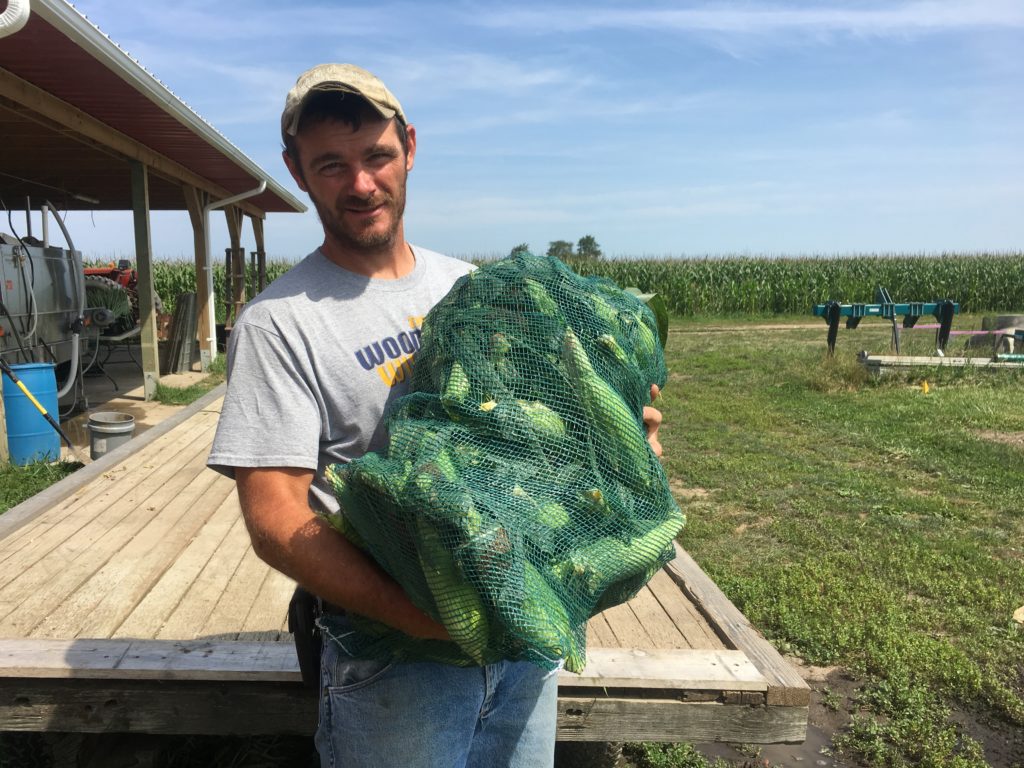
NOW AVAILABLE IN STORE! Bulk corn comes in a bag like this of 64 ears for $35
GREEN KOHLRABI (2) ~This plant was developed by crossing a cabbage with a turnip! The edible part of the plant is an enlarged section of the stem that develops just above the ground. It has a crisp interior like a potato. Store kohlrabi globe and leaves separately. The bulb will last for 2 weeks refrigerated in a plastic bag. Wrap leaves and stalks in a plastic bag and keep in the crisper drawer of the refrigerator. To prep: Rinse under cold running water just before use. Cut the outer skin off with a knife. Trim off the remains of the stalks and root. Grate, slice, or chop as desired. To cook: Cut raw kohlrabi bulb into sticks for a refreshing addition to a raw vegetable tray or grate it for salads. Try raw kohlrabi smeared with peanut butter. Lightly boil, steam or bake it, or add it to stews and stir-fries. Young kohlrabi leaves can be used in recipes calling for greens. To freeze: Cut into cubes or slices and blanch for 3-4 minutes. Place into ice water bath to stop the cooking. Drain and dry. Place in Ziplock freezer bag.
SWEET BANANA PEPPERS (3) To store: Refrigerate peppers unwashed in a sealed plastic bag in the crisper drawer for 1-2 weeks. To prep: Cut in half and remove the seeds from the inside. Slice, chop or mince. To use: Use as you would a bell pepper! Or try roasting peppers over a flame until the skin blackens. Place the pepper inside a plastic bag to cool. Then remove to slide off the skins. To freeze: Wash and dry peppers. Freeze whole or cut into bite-size pieces and place in Ziplock freezer bag, removing as much air as possible.
JALAPENO (1) ~ To store: Refrigerate peppers unwashed in a sealed plastic bag in the crisper drawer for 1-2 weeks. You can also dehydrate peppers for long-term. To prep: Be careful when preparing hot peppers of any kind. For greatest safety wear rubber gloves while chopping and handling them. Do not touch your eyes, nose, mouth or other places. Wash hands thoroughly when finished. Slice off the top of the hot pepper, including the stem. Since the heat in chili peppers is concentrated in the seeds and membranes, you can cut out the heat-filled seeds and membranes for a milder heat. To freeze: Wash and dry. Keep whole, or cut into bite-size pieces and place in Ziplock freezer bag.
RAINBOW SWISS CHARD ~ Chard is a leafy green with a similar taste to spinach. The stems are different colors. The stem is also edible — you can use it for a crunch factor in stir fries (or pickled). To store: Place chard unwashed, wrapped in a sealed plastic bag in the crisper drawer of the refrigerator. Best used very fresh, but may last for a week. To prep: Wash leaves in basin of lukewarm water to remove grit. Fold each leaf in half and slice out the stem. Then stack the leaves up and slice them diagonally into 1-inch-wide strips. To use: Saute in olive oil. Use in soups, spaghetti sauce, pesto, quiche, or dips. To freeze: Blanch washed greens for 2-3 minutes. Rinse in cold ice water to stop the cooking process, drain, and pack into airtight containers. Stems can also be frozen.
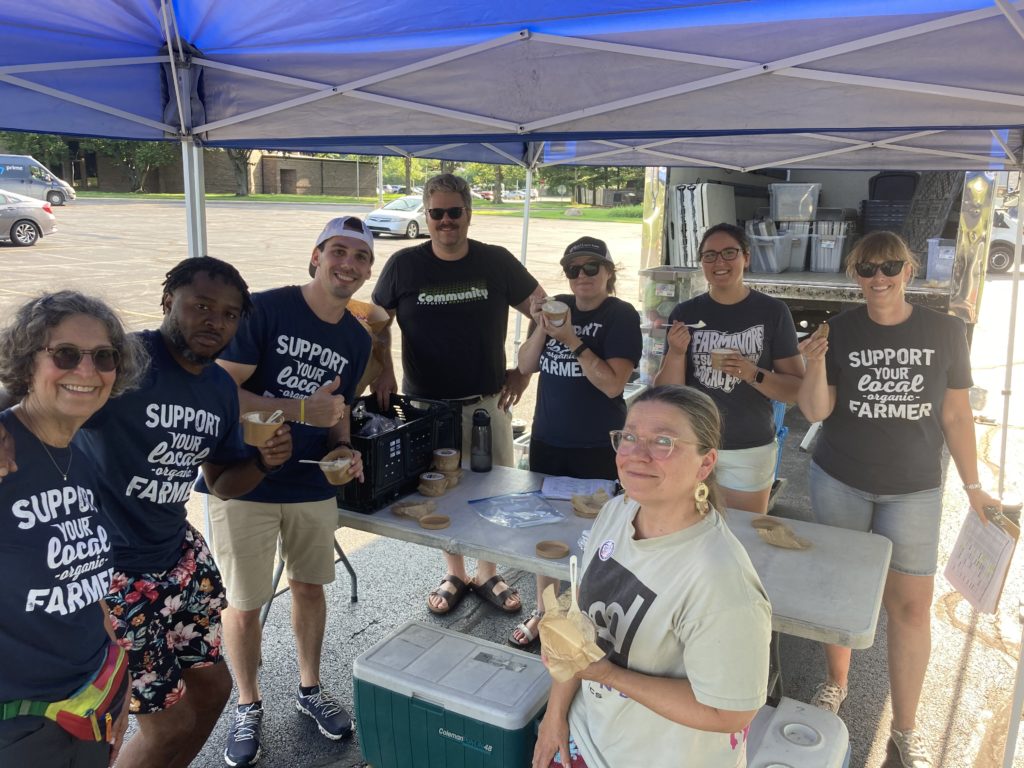
It takes lots of volunteers to make our big sites run! This is our Sylvania crew!
LONG RED TROPEA ONIONS (1 quart) ~ These onions are often called “torpedoes” at our farm, due to their torpedo-like shape. Because they are not cured, these fresh onions will need to be stored in a plastic bag in the fridge and use within 2 weeks. To prep: Peel the onion’s skin and cut off the roots and top. To freeze: Cut or slice onions to desired size and place in freezer Ziplock bag. Remove all the air and seal. It helps to freeze them in 2-3 cup increments.
SUMMER SQUASH (2) ~ You will get some mix of summer squashes — could be green or yellow zucchini, yellow Zephyr crookneck, or patty pans. To store: Store squash unwashed in a perforated plastic bag in the vegetable bin. In the refrigerator they keep for about a week. To prep: Rinse under water to remove the dirt or prickles, and slice off the stem and blossom ends. Then slice or chop. Scrape out seeds from baseball bat sized zucchinis before using them to bake. To use: Slice tender, young summer squash raw into salads. Try them in stir-fry or with pasta. Lightly steam (4-5 minutes) and dress them with fresh herbs or pesto. Or coat squash lightly in oil and roast at 350 degrees whole or sliced in half for 15-45 minutes. Stuff whole squash with your favorite stuffings. Bread them and make zuke fries. To freeze: You can freeze grated zucchini for use in breads and muffins. Squeeze as much liquid out as possible before adding to the freezer bag.
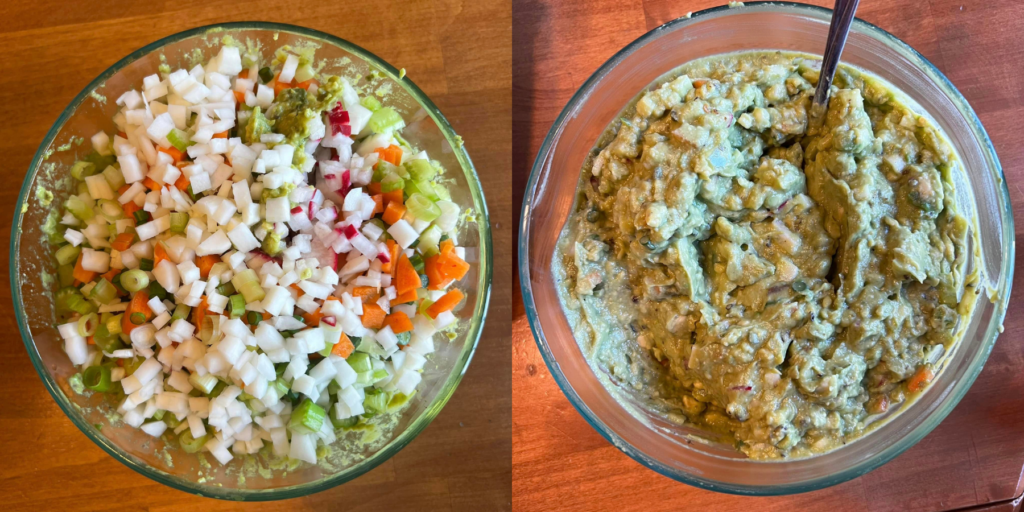
Melinda made a veggie-full guacamole. This reminded me of a spin on veggie cream cheese. Great idea, M! You win a prize for your innovation this week.
CUSTOMER PHOTO OF THE WEEK!
This week’s photo goes to Melinda Fluckinger of the Port Clinton site. She showcased a new vegetable exit strategy: veggie-full guac!
“One of my favorite exit strategies is veggie-full guacamole! This had radish, turnip, carrot, garlic scape, kohlrabi, and green onion. I cut up some more of the veggies and fruit for a charcuterie board featuring three of our cheese share goodies – Street Ched, Gouda, and Charloe. Amazing and simple summer supper!”
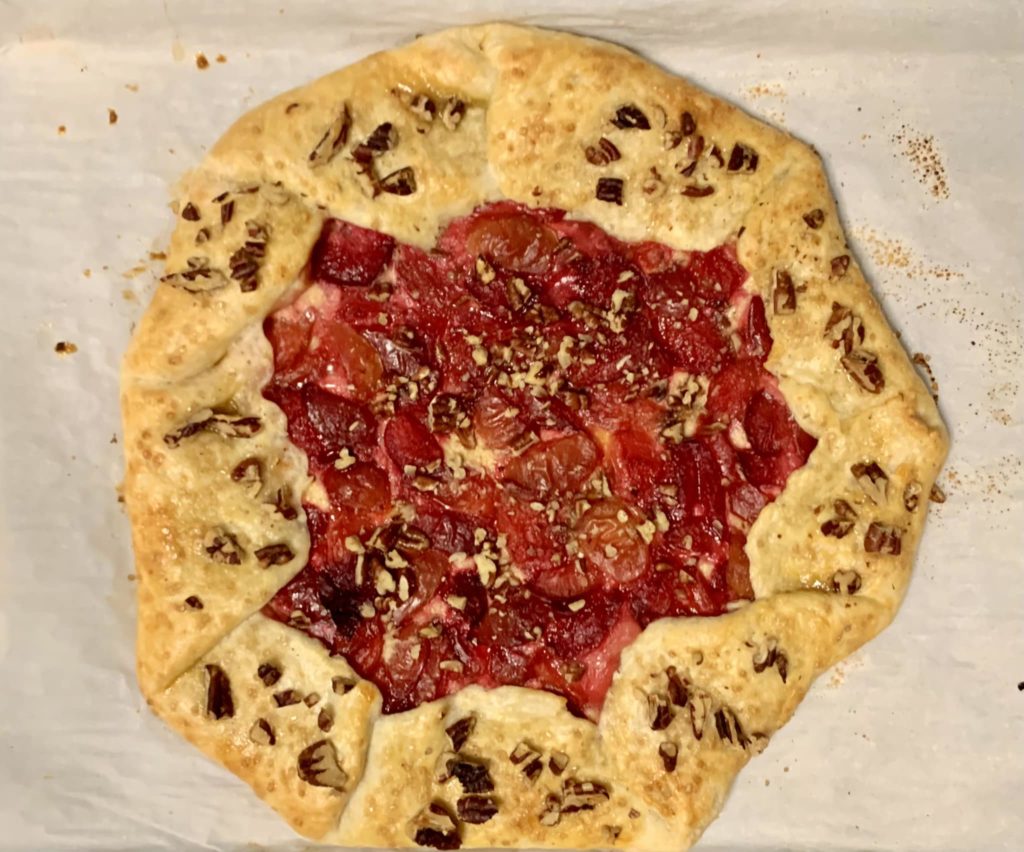
Plum galette brought to you by the legendary Robert Seaney.
WEEK #6 ADD-ON SHARES: We are Week “B”
Odd-numbered weeks of our CSA season (week 1,3,5) are called “A” weeks. And even-numbered weeks (week 2,4,6) are called “B” weeks. If you have any kind of non-veggie, bi-weekly share, you have been assigned to either “A” or “B” week for the season. If you get a cheese share, it always comes on Week “A.”
WEEK 6 FRUIT SHARE:
WHITE PEACHES ~ (via Quarry Hill Orchard) – if these are hard as a rock, you’ll want to store them on the counter until they ripen. THEN put them in the fridge.
BLACKBERRIES (Mark Maag Farms) ~ These are highly perishable. Eat within 3 days. You should rinse them before eating. Try rinsing in a vinegar bath and then air dry to give them longer shelf life. Store in fridge.
Ice Cream Flavor of the Week:
BLACKBERRY SWIRL from Knueven Creamery. Note: be sure to stop and pick up your ice cream from the Knueven milk truck at your pickup site! They will be located either right before or after your veggie pickup. Your farmers will not be passing this out in their delivery line.
Coffee Flavor of the Week:
BRAZIL BOB-O-LINK: Maddie & Bella Coffee Company ~ complex, creamy, rich in chocolate flavors
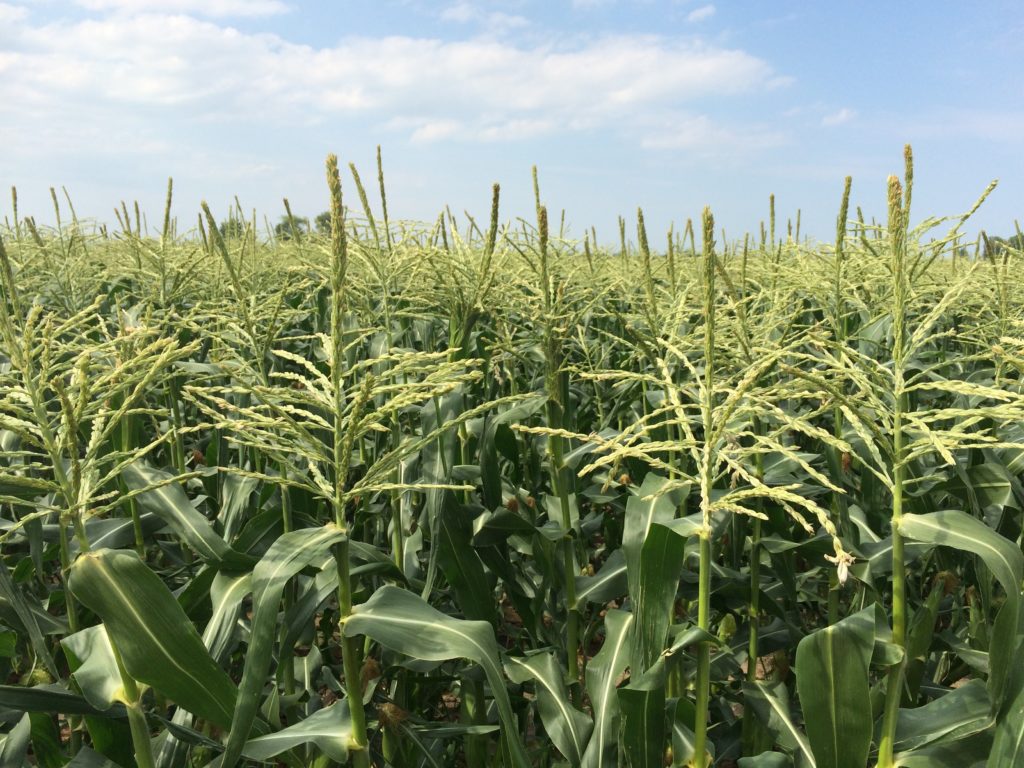
The sweet corn tassels sway in the wind and blow their pollen down below where it can fertilize the ears.
The Difference between Field Corn and Sweet Corn
I’m always surprised how many people don’t realize the difference between field and sweet corn, considering how much of a staple both these crops are in the American diet. Farmers can grow both. And if you came out to our neighboring fields and actually looked at the two different plants, you would see a noticeable difference in their physical characteristics. So in this week’s article, I’m going to spell out the difference between the two plants.
Sweet corn is what we commonly think of when we picture eating corn on the cob or frozen corn from the freezer aisle. Sweet corn is grown for human consumption. The plant stalk is about 5 feet tall. It is planted in mid-April, and usually “tassels” and begins forming its ears at the end of June. My dad grows our CSA’s sweet corn for us. We don’t usually harvest it until mid-July at the earliest. All the sweet corn is picked by hand, although we do use a conveyer machine called “Veg-Veyer” to make things a bit easier. A tractor pulls this conveyer belt system behind, and the pickers walk down a row, pulling 1 ear off each plant and throw them on the moving conveyer belt in front of them. This belt then takes the corn ears up to a giant storage box, which is eventually placed in a cooler until it is packed.
Two of our crew get up every morning to meet up with Kurt’s dad to pull corn for about 1.5 hours. They like to do it early before it gets too hot. The fields are often soaking wet with dew, so our pickers will wear protective clothing — sometimes even waterproof jackets to keep from getting wet and itchy. It’s always an anticipated time — the first picking of the sweet corn. It’s exhausting work though, and it soon becomes a chore after a few weeks. It takes an experienced hand to “feel” whether a corn husk is ready for picking. If the tops feel plump, indicating the kernels have ripened all the way up the ear, then it’s ready to pick. If the ear isn’t ready, it’s passed by, and left behind (and often not picked later, truth be told). Having a good crew in the picking zone is critical to getting this job done well. Fast pickers really help move the project along and keep the crew motivated.
Our dad’s sweet corn is sprayed for worms a few times using a conventional spray. For this reason, we don’t intermingle the corn in our CSA box. The sweet corn grows from a hybrid seed, meaning it’s not GMO. In fact, GMO sweet corn is still pretty rare — it’s only beginning to show up around the country. GMO corn seed is widely used for field corn — in fact around 90% of field corn is GMO. So what’s field corn?…
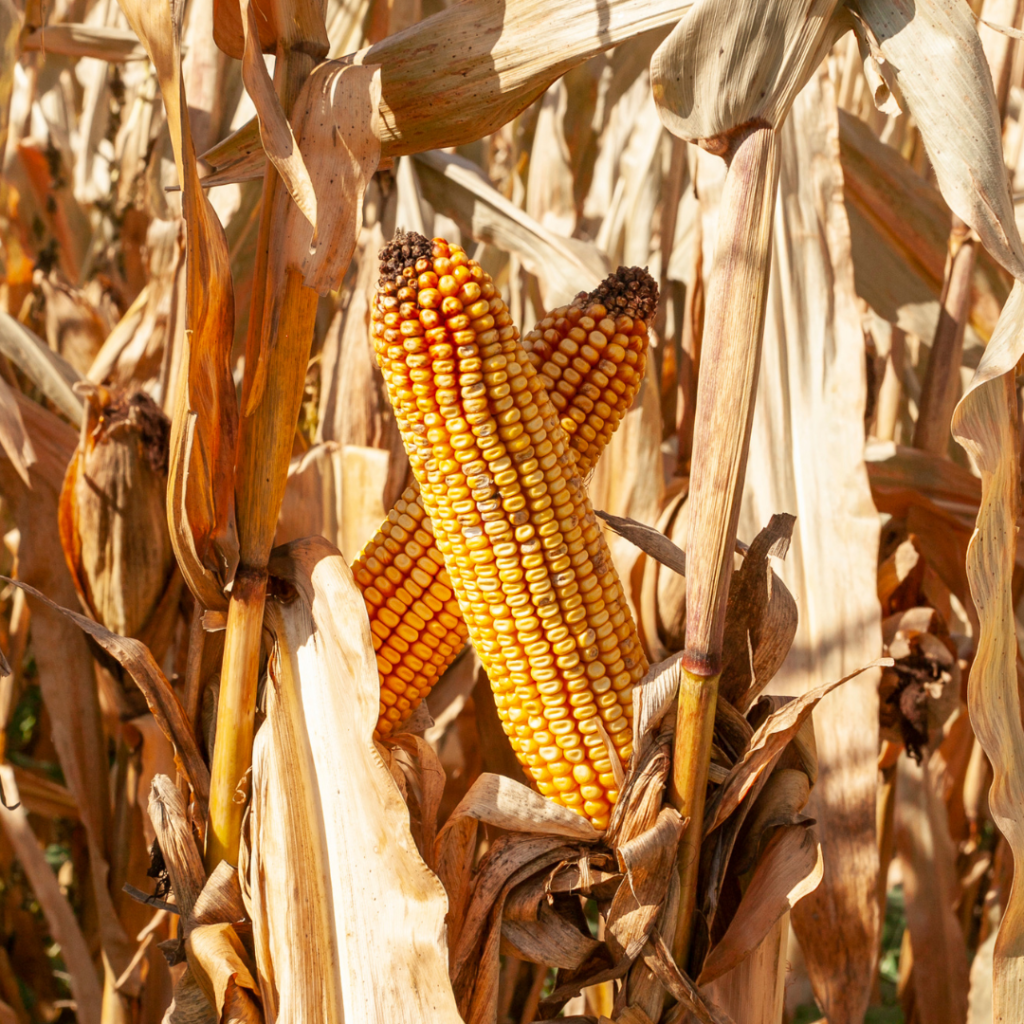
This is what field corn looks like before it is harvested by the combine. It is not picked until it is VERY dry.
The field corn plant is grown primarily for animal feed and processed foods. According to the USDA, about 88.8 million acres were planted in field corn in the US in 2015. This corn stalk grows higher than its cousin — about 9 feet high, and farmers don’t harvest it until the fall, when the corn plant has died. At this time all of the plant is brown and the ears hang down. The corn husks likewise have lost most of their moisture, with the corn kernels looking dehydrated and ready to pop off the cob. It is then that you see the army of combines coming out in the field to “shell” or cut the corn. This dried corn is then loaded into grain trucks and hauled to the grain elevators for sale, or stored locally on the farm in a silo to feed to animals over the winter. Corn that is sold to the grain elevators (like the Andersons or Archer Daniels Midland in Toledo) is often stored in these locations for long periods of time, and shipped via vessel across oceans or over land by rail. Each grain elevator has a U.S. inspector inspecting the corn as it is loaded onto vessels, making sure that it passes certain grade levels. A certain percentage of damage (spoiled product) is allowed.
Field corn goes many different directions from here. Some goes to processors to be made into products like corn starch, some goes to feed live stock and some goes to ethanol plants to be made into a fuel additive and some will go into food additives (like high fructose corn syrup). Take a look at your food ingredient labels… anywhere you see “corn syrup,” or “corn starch,” you’re consuming this field corn. As a side note, the field corn that is grown for processing and animal feed is almost all GMO (genetically modified). That means that any of the processed food that you ingest has this GMO corn in the food chain.
I still remember a time last summer, when we were driving through Illinois on vacation, and we saw a car parked on the side of the road. A guy was stealing what he probably thought was sweet corn from the farmer’s field and hopping back into his car. I shook my head, chuckled and said under my breath, “Hope you enjoy that starchy field corn, buddy!”

Kurt looks out over a ridge line at the top of Hansons Point in the Red River Gorge.
FARMER KURT’S FIELD NOTES
This week, we took off on vacation. So most of today’s “field notes” will be about our vacation to the Kentucky Red River Gorge. First, we need to thank CSA member Elizabeth Tore for mentioning this spot to us. We’d never heard of it. But she told Corinna about it while she was volunteering one weekend for us. WOW! What a great place. And to think it’s been here all this time — only 5 hours away. On the way there, we stopped at a place called Jungle Jim’s outside Cincinnati — our first time there. I’m sure many of you know about it, but we’d never been. I lost my family and wandered the many aisles looking for them holding heavy cases of beer. (We forgot to get a cart).
We stayed in a very nice AirBnB in Stanton, KY, that was very large, with a huge backyard that looked out on a forest of trees. We spotted a pheasant and even a red fox while we were there from the screened-in back porch. I really appreciated the big kitchen, because Corinna brought ALL of our own produce from the farm, and we had some fabulous home-cooked meals while we were there.
We discovered a new soda beverage in Kentucky called “Ale 8 One.” It’s a ginger ale, that was burn during the time of Prohibition. It was EVERYWHERE… and I mean everywhere. Of course we had to try some, and bring back a case of a new limited edition blackberry flavor.
Everyday, we did some hiking, to the tune of 3 hours. We did Hanson’s Point, Star Gap, the Natural Bridge, Gray’s Arch loop trail. Corinna got eaten up by chiggers pretty bad and has the bites to show for it still. Our boys were troopers — it was downright muggy on the last day, and they didn’t complain one bit! On the last day, we spent a nice afternoon playing in the park’s waterhole and jumping off this huge boulder into the water. It’s called Jump Rock and it was the highlight of my stay. The area reminds me a little bit of Hocking Hills, but better. It’s in Daniel Boone National Forest, so we felt like we were really remote. Some of the trails weren’t marked as well, and we had to rough it a bit. I like adding a little bit of excitement to my hike! The trails often dipped down near the Red River, and then climbed back up to these magnificent ridge lines, where you can walk out to see a whole forest below you. We never did find the “arch” at Star Gap, but we had some fun trailblazing for sure. On the last hike, we actually saw a black bear about 5 minutes from our parking lot. We froze, watched it pass by, and then we stayed put for about 5 minutes before booking it back to the car!

That’s me jumping off Jump Rock!
At the house, our boys blazed through a bunch of old A-Team DVDs when we were relaxing back home. We played a round of RISK, where Jed kicked our butts. And Corinna did a couple of puzzles. I slept a few times, drank a few beers. It was very relaxing. I want to thank you all for allowing us to take a week off — my batteries always need a recharge right about now. And it feels like I have the energy to be able to do another big sprint here for a few weeks!

Our crew finishes up a weeding session.
Upon our return, I jumped right back into the thick of it! It’s going to be a VERY busy sprint here in the next 3 weeks, as the sweet corn is now officially in season. My dad will want that picked every day, so several of our guys disappear for the morning block to help with that, leaving me with a smaller crew. The tomatoes are this close to turning red, and when they do, they come all at once it seems! And of course, the summer squash — well, it just keeps on coming, doesn’t it? Soon our days will be filled with the rhythms of regular harvest, and the challenge becomes how to fit in the other farm tasks that also need doing.
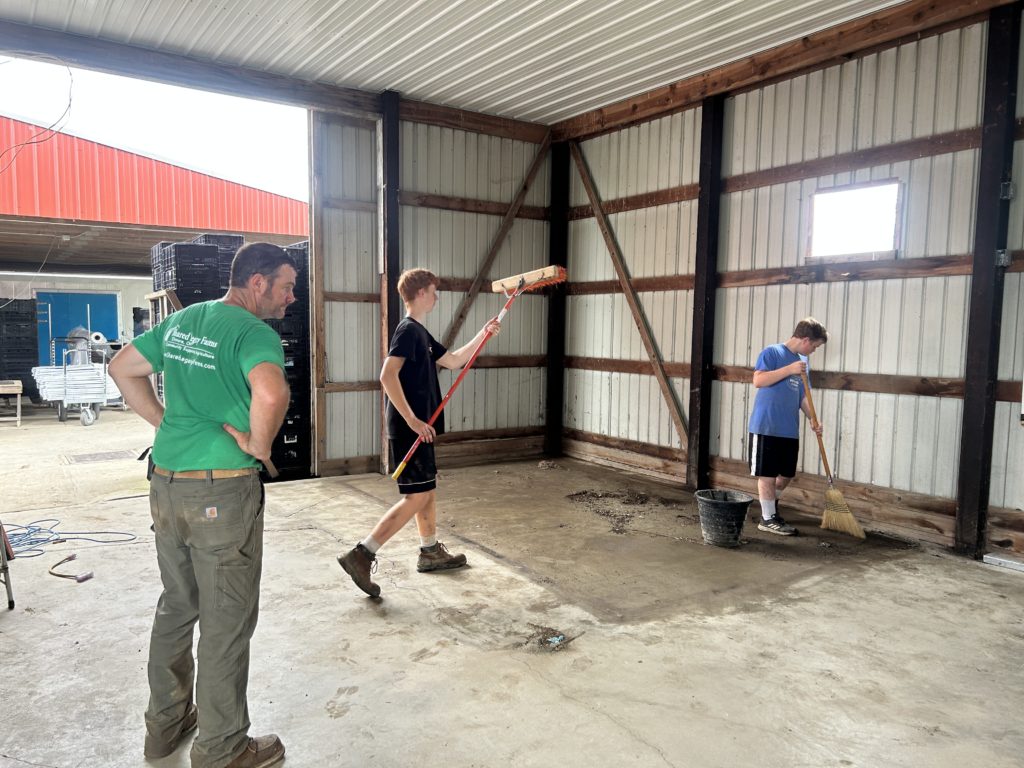
The cooler was disassembled in the packing shed, leaving a big open area!
The big project this week was to get the pack shed cooler disassembled. Taking out the cooler has opened up some major space in our pack shed. I’m excited to play around with the space. The new cooler is now operational. I’ve started moving product into the space. It’s so awesome.
My dad has started harvesting melons this week — not enough yet for the fruit share. But soon… we got some good rain this past week while we were away. The weather seems to be cooperating so far this year. I’m hoping it cools down for our first Farm Dinner this Saturday night. Looking forward to seeing some of you there.

Corinna and I did a 3 hour hike to see this arch called Gray’s Arch.
Sweet corn is heading your way this week! This corn comes from my parents right next door, David Bench Farms. It is known as the “best” sweet corn in NW Ohio. This is the one product that is not organic that you’ll see in your share. We pack it separately in a bag and place it on your box when you give it to you. Sweet corn is sprayed for worms with a conventional spray. However, it is not GMO.
Before we left for vacation, I took some time to head over to Noah’s place with John, and we brewed up a batch of cherry beer. It’s fermenting on my kitchen countertop, and should be ready to bottle up in a few days. Can’t wait to show it to you…
~Your Farmer, Kurt
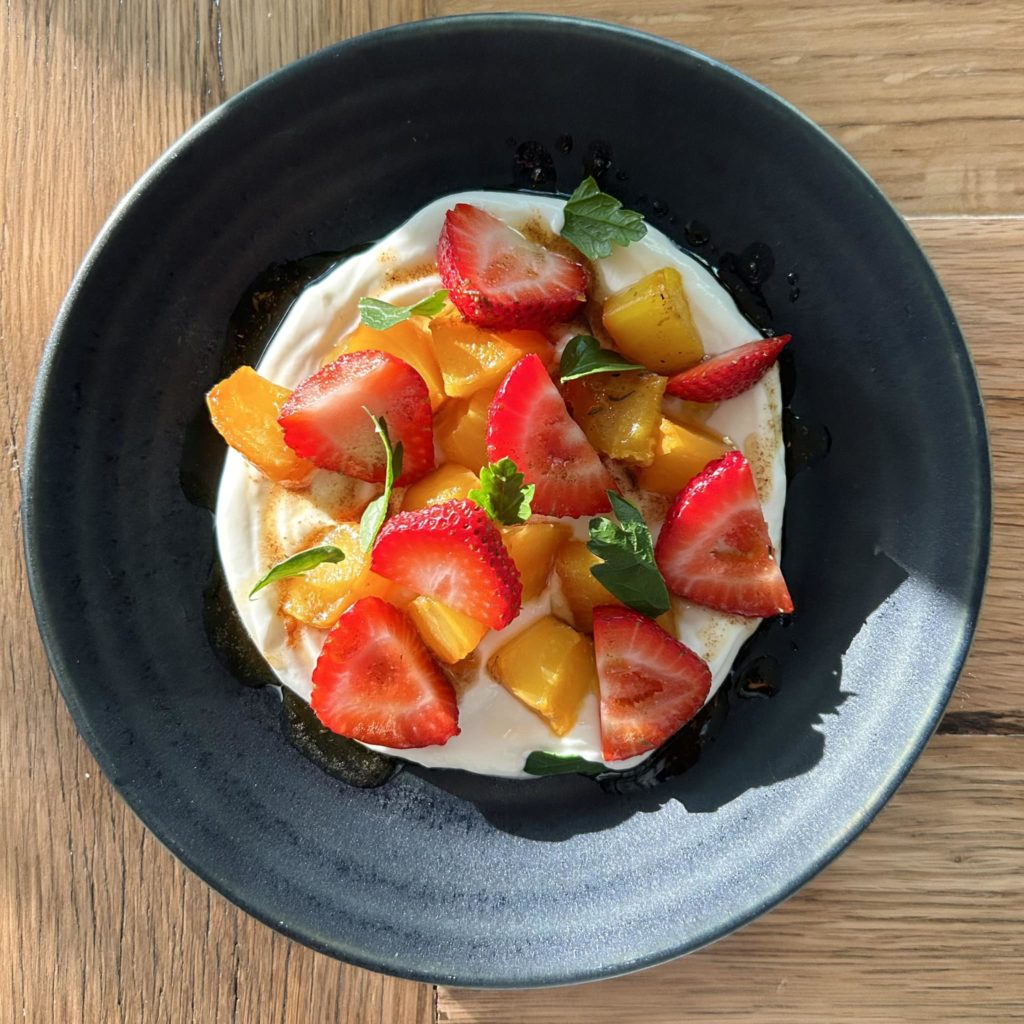
Jean Modene made this beet strawberry salad last week. Her husband declared it was the best salad ever.
WEEK 6 ANNOUNCEMENTS
- Announcing! The Winners of CSA Bingo!… Stephanie Book and Kate Lynn. Congratulations! You will receive a prize this week with your box. Thanks to everyone who participated.
- Shop Our Online Store This Week for More Goodies: Our store link is super easy to remember: www.sharedlegacyfarms.com/store. Just be sure to select the right pickup site that coincides with your pickup location. If the pickup option is greyed out or not available, it means you missed the window to order. You need to place your order 36 hours before your site. We harvest the product on Monday and Wednesday mornings — early. This week, the store will have: sweet corn (by the dozen, or in bulk bags, not organic), orange carrots, 1.5# (no tops), peaches, globe tomatoes (4-pack), red beets (by the quart or in bulk), gold beets (by the quart or in bulk), blonde mini snack-size cucumbers (only 50 quarts), pesto basil bag (8 oz bag), 3-pack of smaller green cukes, head lettuce, blackberries, red long tropea onions (by the quart), hakurei turnips CLEARANCE (no tops), red turnips (no tops), medium-size green cabbage, arrowhead cabbage, Swiss chard, curly kale, SLF trucker hat merch, SLF swag stickers, honey, creamed honey, and maple syrup.
- BULK BEETS are now on sale in the store. You get a 15 pound bag for $25. Choose between red beets or golden beets.
- BULK CORN can be ordered in our online store. We’ll have this for the next 6 weeks. The best time to buy bulk corn is in August, when the ears are largest. A bushel bag goes for $35 and includes 64 ears. We only have a limited amount of space on our trucks, so if we sell out, just hang on tight and be ready to order next week. If you want to learn how to freeze sweet corn, watch our video tutorial here. I recommend the Corn Cutter from Pampered Chef (affiliate link) to make it a whole lot easier, as well as an angel food cake pan or bundt pan.

Cory Wolin shared this photo of his salmon, lentils, and fresh herb salad.
WEEK 6 CSA RECIPES
Members: You can download these recipes as a PDF here. These recipes are designed to inspire you to use your box this week! Please check inside our private Facebook group to find your fellow members sharing ideas for what to make with their box! Share a photo and you might be featured in next week’s newsletter!
Roasted Vegetable and Kohlrabi Noodle Bowls with Peanut Sauce
Kohlrabi Slaw with Jalapenos
Carrot Zucchini Mini Muffins
Garlicky Swiss Chard and Chickpeas
Pickled Onion and Carrot Relish
Honey Lime Tilapia and Corn Foil Pack
Southwestern Black Bean and Corn Salad
Jalapeno Popper Creamed Corn
Summer Squash and Onions
Rainbow Chard and Carrot Hash
Swiss Chard Frittata
Stuffed Banana Peppers
Easy Pickled Banana Peppers
Grilled Balsamic Peaches
Pickled Peach Salad
Beet and Berry Smoothie

